Autumn is a magical time for gardeners, filled with rich colors, cool breezes, and unique floral displays. While many plants finish blooming by the end of summer, there are countless flowers that thrive in the crisp fall air. These autumn-blooming beauties bring warmth and charm to gardens, extending the season of color when leaves begin to change.
Flowers that bloom in autumn are not only visually stunning but also important for supporting late-season pollinators. Bees, butterflies, and hummingbirds rely on these blossoms for nectar before winter arrives. From vibrant asters and salvias to delicate toad lilies and camellias, each plant adds a unique touch to fall landscapes.
Whether you want to brighten up garden beds, attract wildlife, or create beautiful container arrangements, autumn-blooming flowers offer endless possibilities. In this guide, you’ll discover 45 spectacular flowers that bloom in autumn, along with their characteristics, blooming time, USDA zones, and essential care tips.
Common Flowers That Bloom in Autumn
Chrysanthemums (Mums)
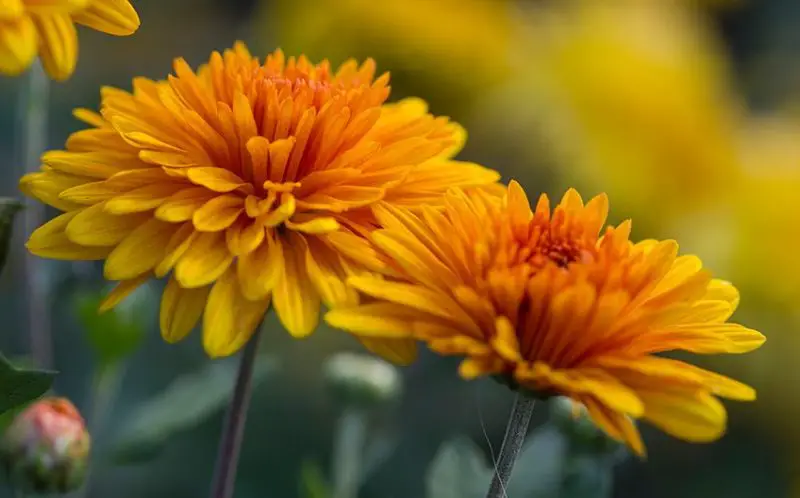
Chrysanthemums, commonly called mums, are among the most iconic flowers of autumn in North America. These perennials are known for their dense, bushy growth and an impressive range of flower forms, from decorative pompons to daisy-like shapes. Their colors vary widely, including shades of yellow, orange, red, purple, pink, and white, making them a favorite for fall gardens and seasonal decorations.
They typically bloom from late summer through the peak of autumn, often lasting until the first frost. In USDA hardiness zones 5 to 9, mums thrive outdoors, while in colder regions, they can be grown in containers for seasonal color. Gardeners can easily recognize them by their tightly packed flower heads and deep green, serrated leaves.
To grow mums successfully, plant them in well-draining soil with full sun exposure. They prefer regular watering but should not be overwatered to prevent root rot. Pinching back the stems in early summer helps encourage bushier growth and more blooms in autumn. Adding mulch in late fall can protect their roots and help them return the following year in suitable climates.
Asters
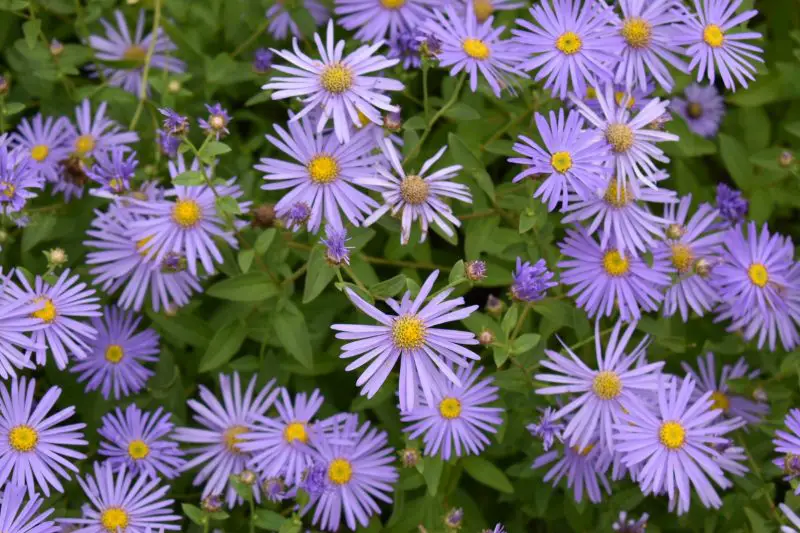
Asters are late-blooming perennials that bring vibrant color to fall gardens with their star-shaped flowers. Their name comes from the Greek word for “star,” which perfectly describes their appearance. Asters can grow from 1 to 6 feet tall, depending on the variety, and their flowers range in color from purple and blue to pink and white, with a yellow central disc.
They usually bloom from late August through October, providing nectar for pollinators during the cooler months. Most varieties perform best in USDA hardiness zones 4 to 8, making them a reliable choice for many North American gardens. Their bright flowers and slender, lance-shaped leaves make them easy to identify, often appearing in clusters that attract butterflies and bees.
Asters grow best in full sun to partial shade and prefer moist, well-drained soil. Deadheading spent flowers can prolong blooming into late autumn, and dividing clumps every few years helps maintain plant health. Adding compost or organic mulch around the base helps retain moisture and keeps the roots cool during warm early fall days.
Goldenrods
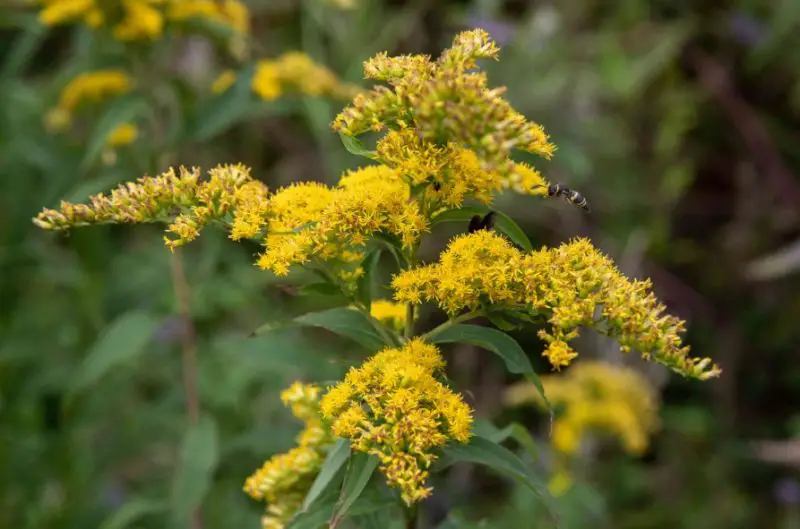
Goldenrods are hardy perennials that add a cheerful splash of yellow to fall landscapes. Known for their tall, upright stems topped with dense clusters of tiny golden-yellow flowers, goldenrods can grow from 2 to 5 feet tall. Their vibrant color brightens gardens, fields, and roadsides, often mistaken as the cause of fall allergies, although ragweed is the true culprit.
They bloom profusely from late August through October, thriving in USDA hardiness zones 3 to 9. Goldenrods are easily identified by their plume-like flower clusters and slender, lance-shaped leaves that grow alternately along their stems. They are a magnet for pollinators, including bees and butterflies, during the late season when few other nectar sources remain.
These plants are low-maintenance and grow best in full sun and well-draining soil. Once established, goldenrods tolerate drought conditions well and require little care. Cutting them back after flowering can prevent unwanted self-seeding, as some species can spread aggressively in ideal conditions.
Autumn Crocuses
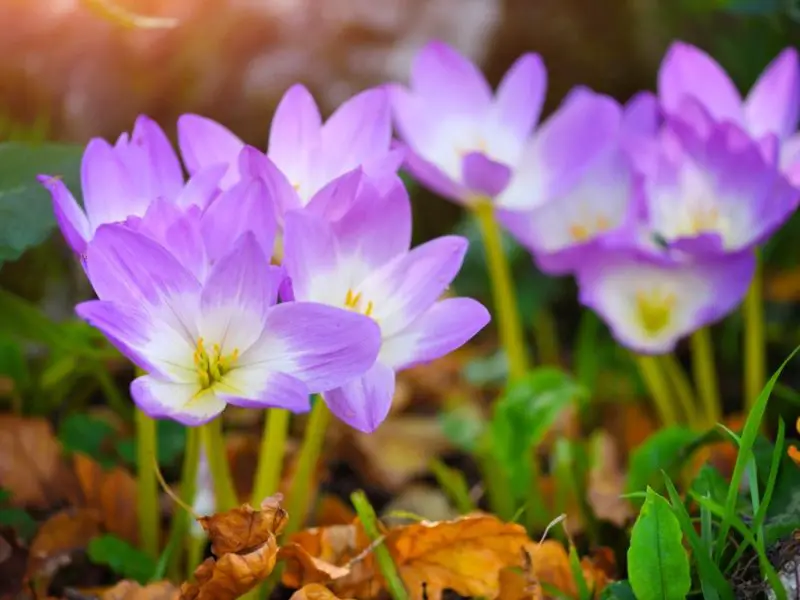
Autumn crocuses (Colchicum autumnale) are unique fall-blooming bulbs that resemble spring crocuses but belong to a different plant family. Their cup-shaped flowers appear in shades of pink, lavender, or purple, sometimes with white varieties. The flowers emerge directly from the soil without foliage in autumn, creating a striking appearance in gardens.
They bloom from September to November, depending on the climate, and are suitable for USDA hardiness zones 4 to 9. Unlike spring crocuses, autumn crocuses send up their leaves in spring, which then die back by summer before the flowers emerge in fall. They are easily recognized by their larger flower size and more delicate, translucent petals.
To grow them, plant the bulbs in late summer in well-draining soil under full sun or light shade. They require minimal maintenance, needing only moderate watering during dry periods. Mulching in winter can protect the bulbs in colder regions, and once established, they naturalize well, returning year after year with little care.
Japanese Anemones
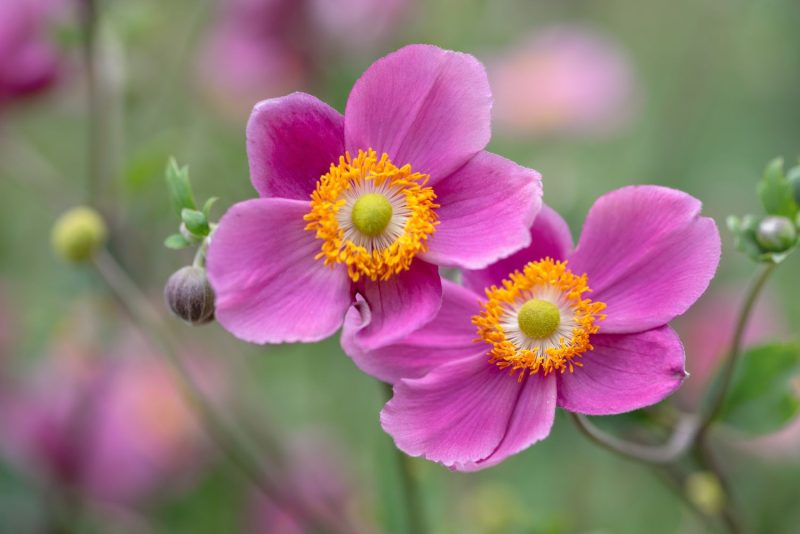
Japanese anemones (Anemone hupehensis and hybrids) are graceful perennials that bring a touch of elegance to fall gardens. They feature tall, wiry stems topped with single or semi-double flowers in shades of pink, white, or lavender. Their soft, delicate petals contrast beautifully with dark green foliage, adding movement and texture to borders.
These flowers bloom from late August through October, providing late-season color when many other perennials have faded. They thrive in USDA hardiness zones 4 to 8, making them well-suited for cooler regions. Japanese anemones are easily recognized by their long stems, which sway gently in the breeze, and their distinctive yellow-centered blooms.
Plant them in rich, well-draining soil with partial shade to full sun, depending on the climate. Regular watering, especially during dry spells, helps maintain strong blooms. Mulching around the base helps keep the roots cool and retain moisture. Once established, they spread gradually, forming attractive clumps that can last for many years with minimal care.
Sedums (Stonecrops)
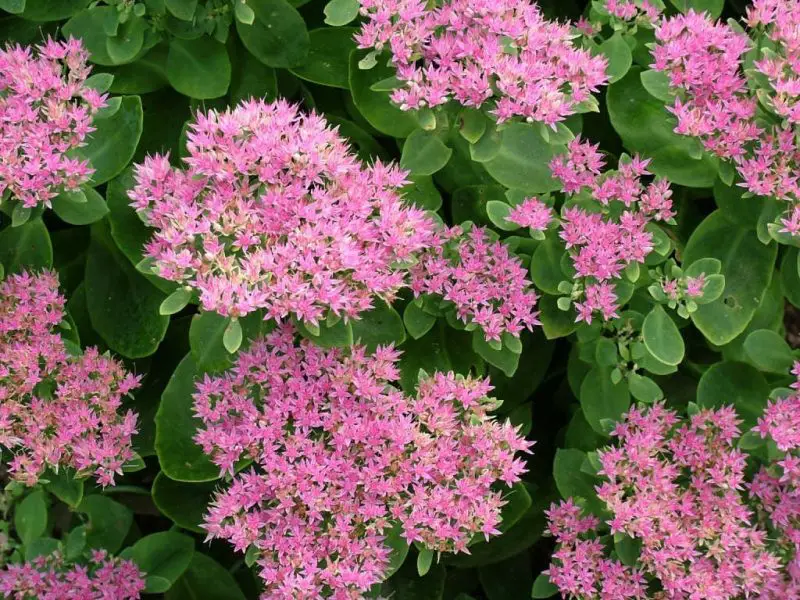
Sedums, also known as stonecrops, are hardy succulents that bring bold color and texture to fall gardens. These low-maintenance plants feature fleshy, water-storing leaves and clusters of star-shaped flowers that appear in shades of pink, red, or white. Popular varieties, such as Sedum ‘Autumn Joy,’ are especially prized for their large, flat flower heads that turn deeper in color as the season progresses.
They bloom from late August through October, making them a reliable late-season nectar source for bees and butterflies. Sedums thrive in USDA hardiness zones 3 to 9, adapting well to both garden beds and containers. Their thick, fleshy leaves, arranged in rosettes or upright stems, make them easy to recognize and perfect for adding structure to autumn displays.
Sedums prefer full sun and well-draining soil, thriving in poor or rocky conditions where other plants may struggle. Once established, they are highly drought-tolerant and require minimal care. Deadheading is optional, as the dried flower heads can add winter interest to the garden, but cutting them back in early spring encourages fresh growth for the following season.
Dahlias
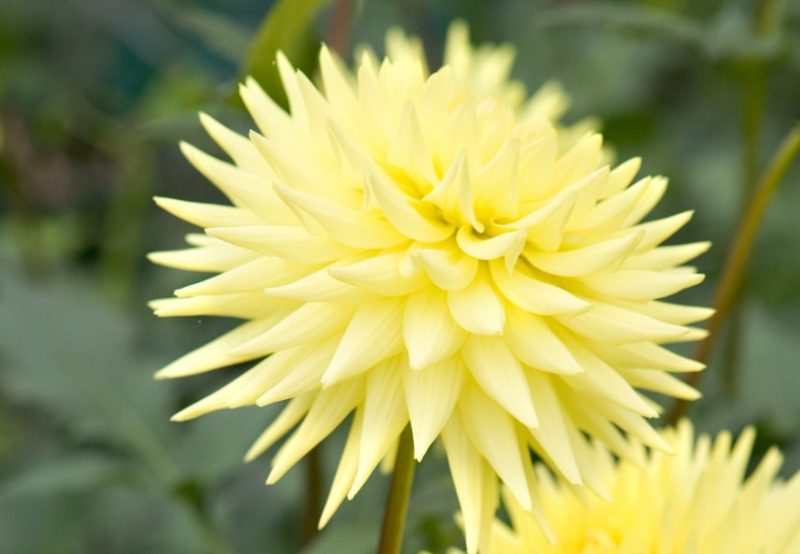
Dahlias are showy perennials that provide spectacular color in autumn gardens with their wide range of flower shapes and sizes. From small pompons to large dinner-plate blooms, dahlias come in vibrant shades of red, orange, pink, purple, yellow, and white. Their lush green foliage and striking flowers make them a centerpiece in late-season landscapes.
They bloom from mid-summer until the first frost, often peaking in early to mid-autumn. Dahlias are suitable for USDA hardiness zones 8 to 11 as perennials, but in colder regions, they are grown as annuals or tubers are dug up and stored for winter. Their large, layered petals and tall stems make them easy to identify and ideal for cut flower arrangements.
To grow dahlias successfully, plant tubers in fertile, well-draining soil in full sun. Regular watering and monthly fertilizing encourage abundant blooms, while deadheading spent flowers prolongs the flowering season. In colder zones, lift and store tubers after the first frost to protect them for replanting the following spring.
Heleniums (Sneezeweed)
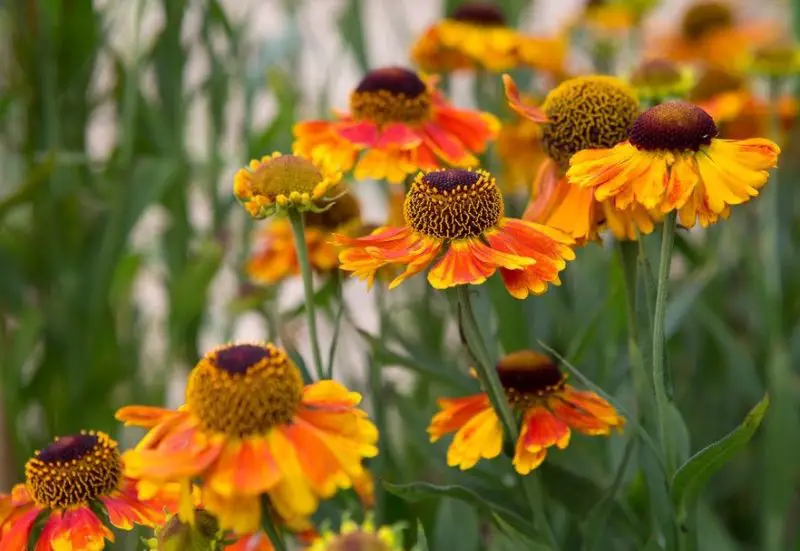
Heleniums, commonly known as sneezeweed, are cheerful autumn perennials with daisy-like flowers in warm shades of yellow, orange, and red. Their slightly drooping petals and raised central cones give them a unique, rustic charm. Despite their name, they do not cause sneezing; the name comes from their historical use in making snuff.
They bloom from late summer to mid-autumn, with peak flowering in September and October. Heleniums thrive in USDA hardiness zones 3 to 8, making them suitable for many North American gardens. Their upright stems, rough-textured leaves, and clusters of bright flowers make them easy to recognize in borders and wildflower plantings.
Plant them in full sun and moist, well-draining soil for best results. Regular watering, especially during dry periods, helps maintain vibrant blooms. Cutting back stems after flowering encourages healthy growth the following year, and dividing clumps every few years keeps plants vigorous and prevents overcrowding.
Rudbeckias (Black-Eyed Susans)

Rudbeckias, commonly called black-eyed Susans, are classic North American wildflowers that brighten autumn landscapes with their golden-yellow petals and dark brown or black central cones. These hardy perennials or biennials are a symbol of late summer and early fall gardens, offering a cheerful and natural look.
They bloom from July through October, with many varieties continuing to flower well into the autumn. Black-eyed Susans are best suited for USDA hardiness zones 3 to 9. They are easily identified by their bold, daisy-like flowers and rough, hairy leaves, which are a favorite among pollinators such as bees and butterflies.
Rudbeckias thrive in full sun and well-draining soil, tolerating poor soils once established. Minimal care is required—occasional watering during prolonged dry spells and deadheading to encourage continuous blooms. Cutting back the stems after flowering can help tidy up the plant, but many gardeners leave seed heads to attract birds in winter.
Joe Pye Weed
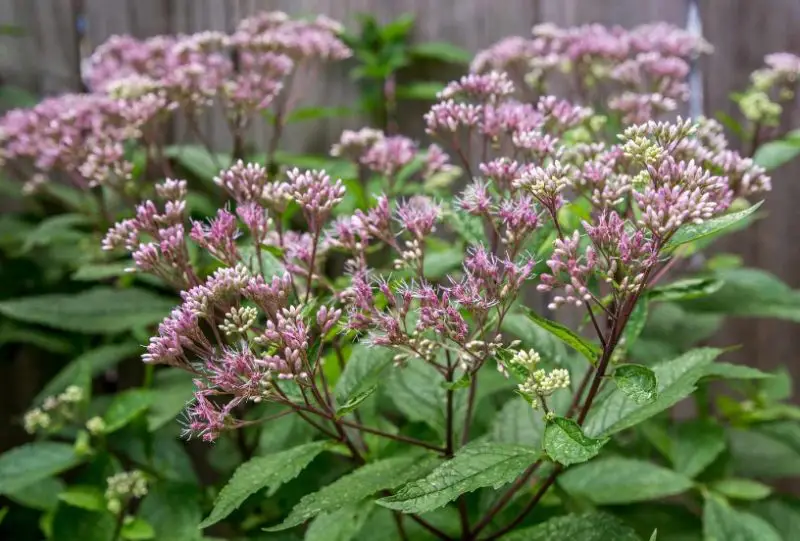
Joe Pye weed (Eutrochium purpureum) is a tall, stately perennial that adds dramatic height to autumn gardens. It produces large, fluffy clusters of mauve or pinkish-purple flowers on strong, upright stems, making it a favorite for attracting butterflies and bees late in the season.
This plant blooms from August through October, thriving in USDA hardiness zones 4 to 9. It is easily recognized by its whorled leaves, tall stems that can reach 4 to 7 feet, and dome-shaped flower clusters. Joe Pye weed is often found in naturalized areas, meadows, and rain gardens due to its love of moist conditions.
To grow it successfully, plant in full sun to partial shade and in consistently moist, rich soil. It requires little maintenance once established, though cutting it back to the ground in late fall or early spring keeps it healthy. Its impressive height makes it ideal for planting at the back of borders or along garden edges for a natural look.
Toad Lilies (Tricyrtis)
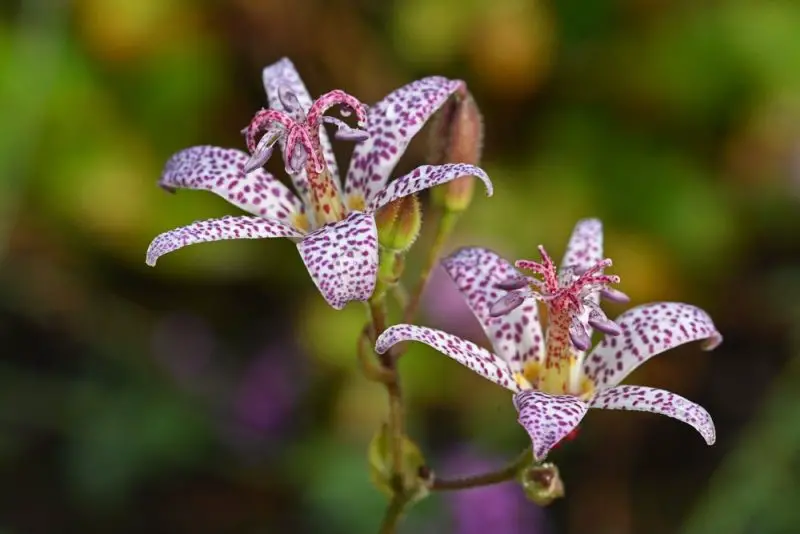
Toad lilies are unique and exotic-looking perennials that add an unexpected charm to autumn gardens. They produce delicate, orchid-like flowers with spotted petals in shades of purple, lavender, and white. The arching stems and lance-shaped green leaves create an elegant appearance, making them stand out among fall-blooming plants.
They bloom from September through October, thriving in USDA hardiness zones 4 to 9. Toad lilies are easily recognized by their speckled, star-shaped flowers, which often grow in clusters along the stems. Their unusual blooms attract pollinators and are especially valued in shaded garden areas where few other autumn flowers thrive.
Plant toad lilies in partial to full shade with moist, well-draining soil enriched with organic matter. They prefer consistent watering, as dry soil can affect flower production. Mulching helps retain moisture and keeps the roots cool. These plants spread slowly over time, forming attractive clumps, and benefit from cutting back old stems after flowering.
Balloon Flowers (Platycodon)
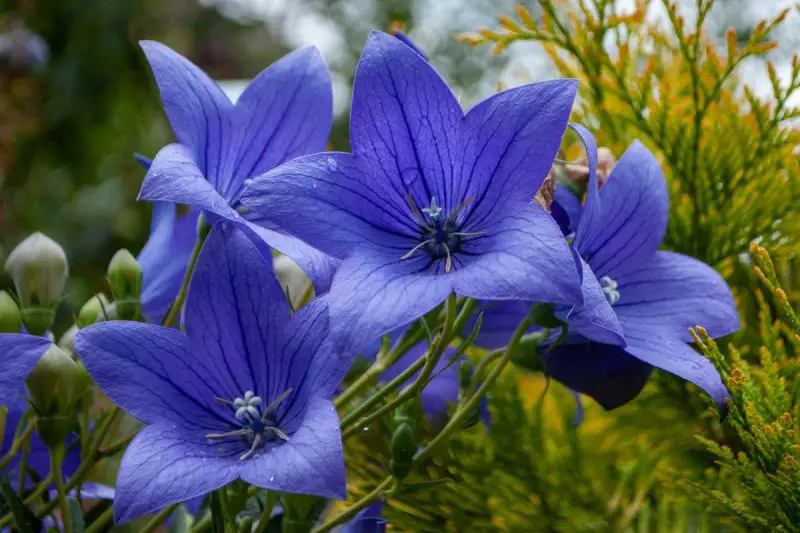
Balloon flowers, or Platycodon, are charming perennials named for their balloon-shaped buds that burst open into star-shaped blooms. The flowers are typically blue, but pink and white varieties are also available. Their upright stems and deep green foliage make them excellent additions to borders and container gardens.
They bloom from late summer into early autumn, often continuing into October in cooler regions. Balloon flowers thrive in USDA hardiness zones 3 to 8. Their puffy buds, which swell before opening, make them easy to recognize and a favorite among children and gardeners alike.
Plant them in full sun to partial shade with well-draining soil. They require moderate watering, and once established, they tolerate short periods of drought. Deadheading encourages additional blooms, while cutting the stems back after flowering helps maintain a tidy appearance. These long-lived perennials can remain in the same spot for years with minimal care.
Camellias (Autumn-Blooming Varieties)
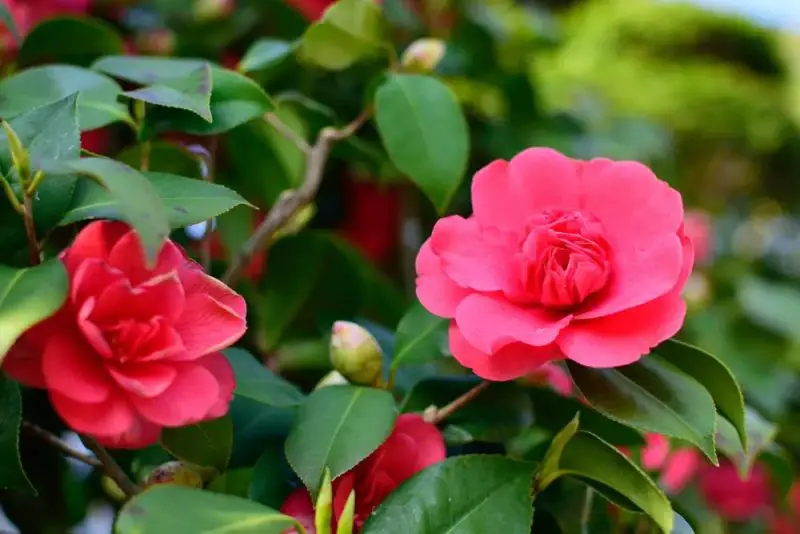
Autumn-blooming camellias, such as Camellia sasanqua, are elegant shrubs that produce delicate, rose-like flowers in shades of pink, white, and red. Their glossy, dark green leaves provide year-round interest, making them valuable ornamental plants in both gardens and landscapes.
These camellias typically bloom from October through December, depending on the region, and thrive in USDA hardiness zones 7 to 9. They are easily recognized by their glossy foliage and delicate flowers that often have a light fragrance. The fall-blooming varieties are particularly prized for providing color when many other shrubs have finished flowering.
Plant camellias in partial shade with acidic, well-draining soil rich in organic matter. Regular watering is essential, especially during dry spells, but avoid waterlogged soil. Mulching helps retain soil moisture and regulate temperature. Light pruning after flowering encourages bushier growth and better flowering the following season.
Salvias (Autumn Sage)
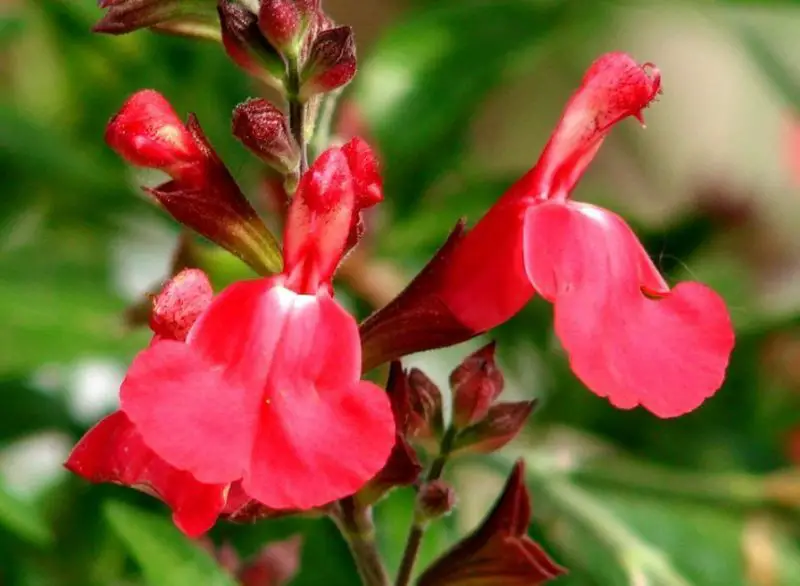
Autumn sage (Salvia greggii) is a compact perennial or shrub that produces small, tubular flowers in vibrant shades of red, pink, purple, or coral. The aromatic foliage adds an extra layer of appeal, and the flowers attract hummingbirds and butterflies throughout the season.
They bloom from late summer through fall, often continuing until the first frost. Autumn sage thrives in USDA hardiness zones 7 to 10, making it ideal for southern and western parts of North America. Its woody stems and clusters of bright flowers make it easy to identify in autumn landscapes.
Plant autumn sage in full sun with well-draining soil. It is drought-tolerant once established and requires minimal care aside from occasional watering during extended dry periods. Light pruning after flowering promotes compact growth and encourages more blooms in the next season.
Monkshood (Aconitum)
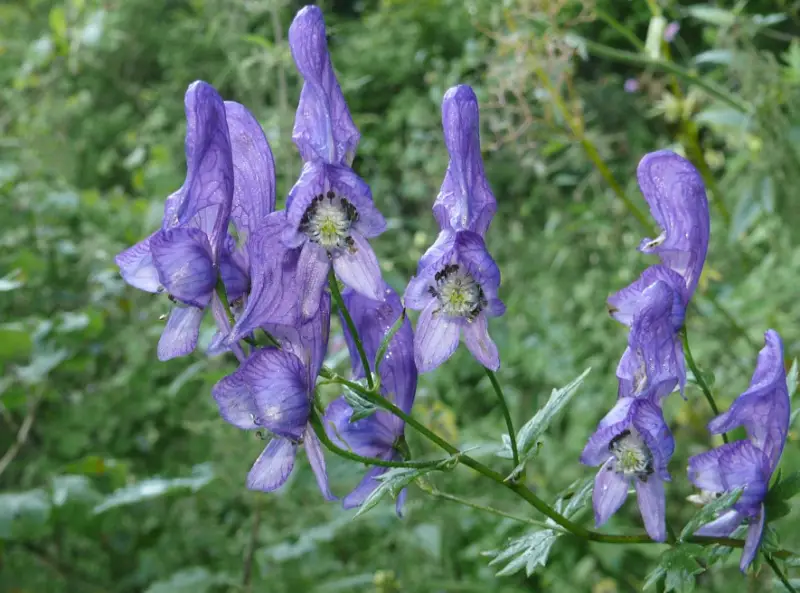
Monkshood, also known as wolfsbane, is a striking perennial with tall spikes of hood-shaped flowers in deep blue, purple, or sometimes white. Its dramatic appearance makes it a standout plant in autumn gardens, but it should be handled with care as all parts are toxic.
It blooms from late summer into early autumn, often peaking in September and October. Monkshood grows well in USDA hardiness zones 3 to 7, preferring cooler climates. It is easily recognized by its helmet-like flowers and deeply divided, dark green leaves.
Plant monkshood in partial shade with consistently moist, well-draining soil. It prefers cooler, sheltered locations and should not be allowed to dry out completely. Tall varieties may need staking to support their height. Due to its toxicity, gloves should be worn when handling or cutting back the plant after flowering.
Colchicums (Meadow Saffron)
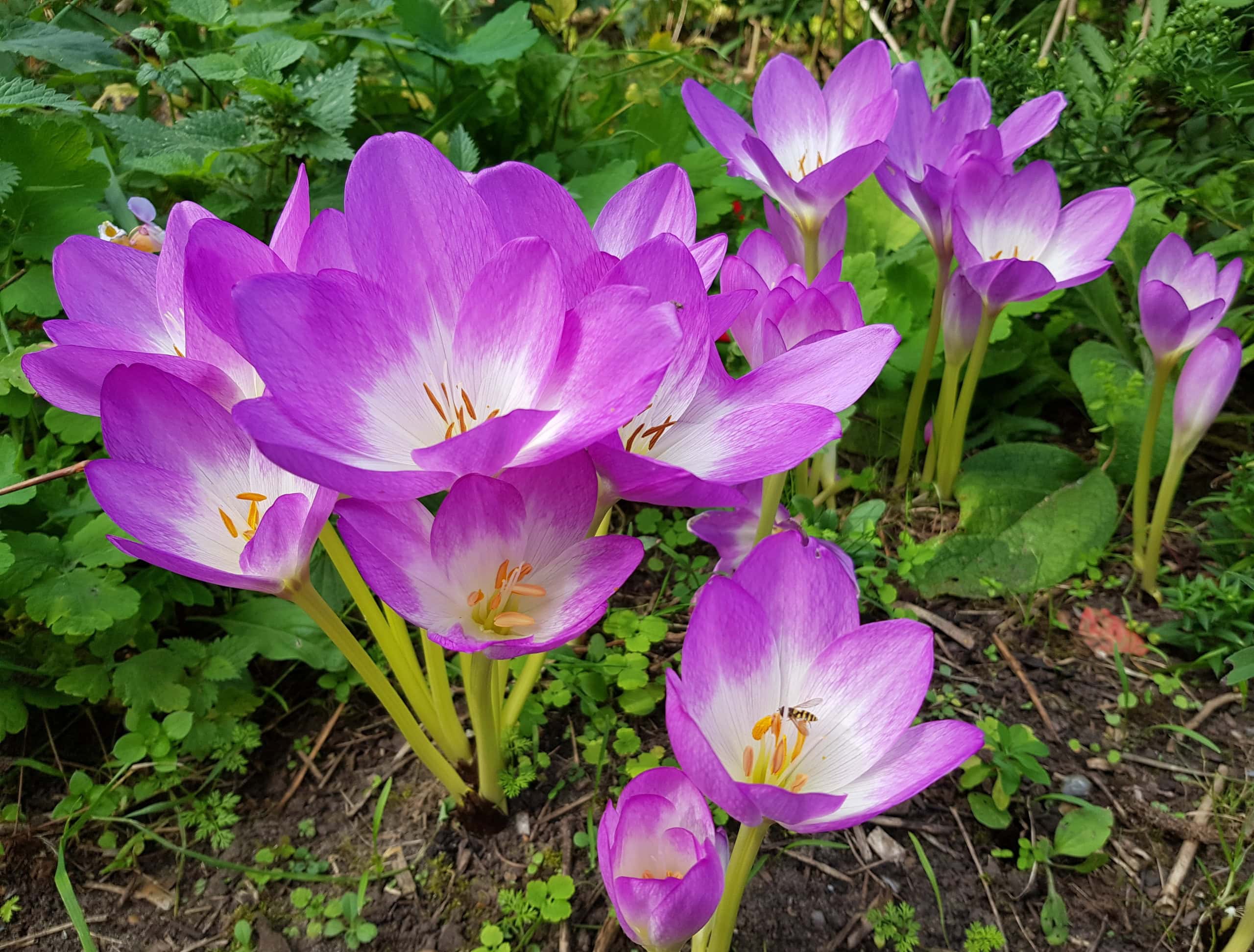
Colchicums, often called meadow saffron, are bulb-like perennials that produce large, crocus-like flowers in shades of lilac, pink, or white. Unlike true crocuses, their blooms are larger and appear without leaves in autumn, creating a magical carpet of color in gardens.
They bloom from September through November, depending on the climate, and thrive in USDA hardiness zones 4 to 9. Colchicums are easily recognized by their funnel-shaped flowers that emerge directly from the soil, while their broad green leaves appear in spring and die back before summer.
Plant colchicum bulbs in late summer in well-draining soil with full sun or partial shade. They require minimal care, needing only occasional watering during prolonged dry periods. Once established, they naturalize easily, coming back year after year. Mulching can help protect the bulbs in colder climates during harsh winters.
Caryopteris (Bluebeard)
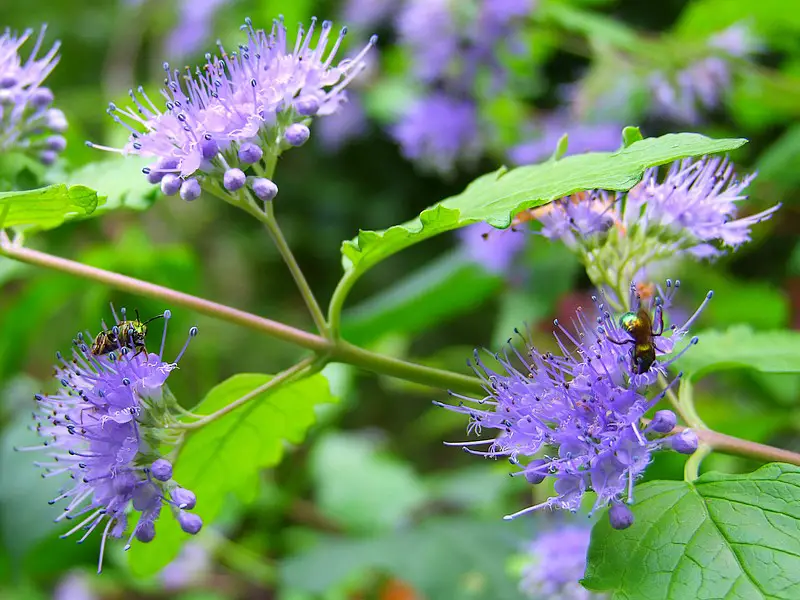
Caryopteris, commonly known as bluebeard or blue mist shrub, is a compact, deciduous shrub that produces clusters of small, blue to violet flowers in late summer and autumn. Its gray-green aromatic leaves add a soft texture to garden borders and attract pollinators, especially bees and butterflies.
It blooms from August through October and thrives in USDA hardiness zones 5 to 9. Caryopteris is easily identified by its loose, rounded form, opposite leaves, and airy sprays of blue flowers that provide a cooling contrast to the warm autumn tones of other plants.
Plant bluebeard in full sun with well-draining soil. It prefers moderate watering but tolerates drought once established. Pruning in late winter or early spring encourages bushier growth and abundant flowers for the following season. Caryopteris is an excellent choice for low-maintenance fall gardens.
New England Asters
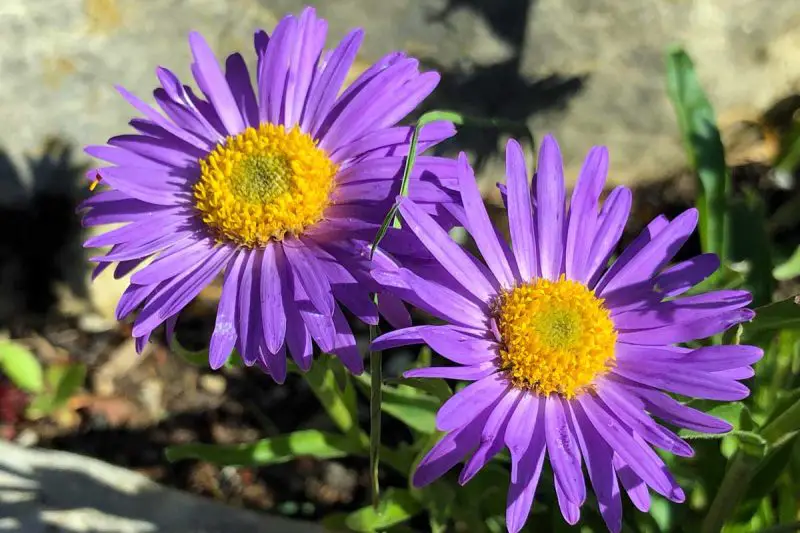
New England asters (Symphyotrichum novae-angliae) are tall, showy perennials that produce masses of star-shaped flowers in purple, pink, or lavender with yellow centers. Their vibrant colors bring a burst of life to gardens in the late season, making them a favorite among pollinators.
They bloom from late August through October and thrive in USDA hardiness zones 4 to 8. New England asters are easily recognized by their tall, hairy stems, lance-shaped leaves, and dense clusters of daisy-like flowers. They are especially valuable for attracting butterflies, including migrating monarchs, in autumn.
Plant them in full sun with rich, moist, well-draining soil. Regular watering during dry periods helps maintain healthy growth, and pinching back the stems in early summer promotes bushier plants and more blooms. Cutting them back after flowering keeps them tidy and encourages strong regrowth for the following year.
New York Asters
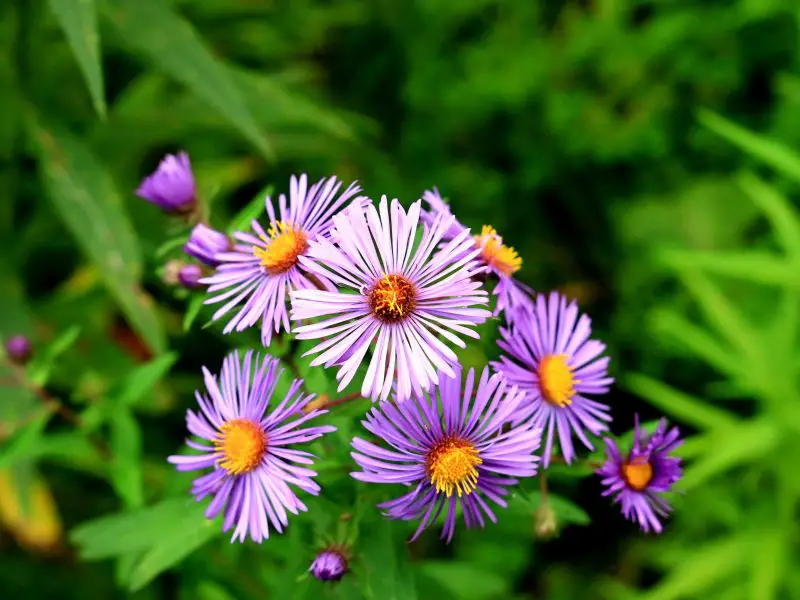
New York asters (Symphyotrichum novi-belgii) are close relatives of New England asters but have a slightly more compact and bushy growth habit. They produce abundant clusters of small, daisy-like flowers in shades of blue, purple, pink, or white, adding vibrant color to fall borders.
They bloom from September through October and thrive in USDA hardiness zones 4 to 8. New York asters are easily distinguished by their smooth, hairless stems and narrower leaves compared to New England asters. Their long-lasting blooms are excellent for cut flower arrangements and for attracting pollinators late in the season.
Plant them in full sun with well-draining soil, and provide regular watering during dry spells. Dividing clumps every few years helps maintain plant vigor and prevents overcrowding. Deadheading spent blooms encourages a longer flowering season and keeps the plants looking fresh through autumn.
Turtleheads (Chelone)
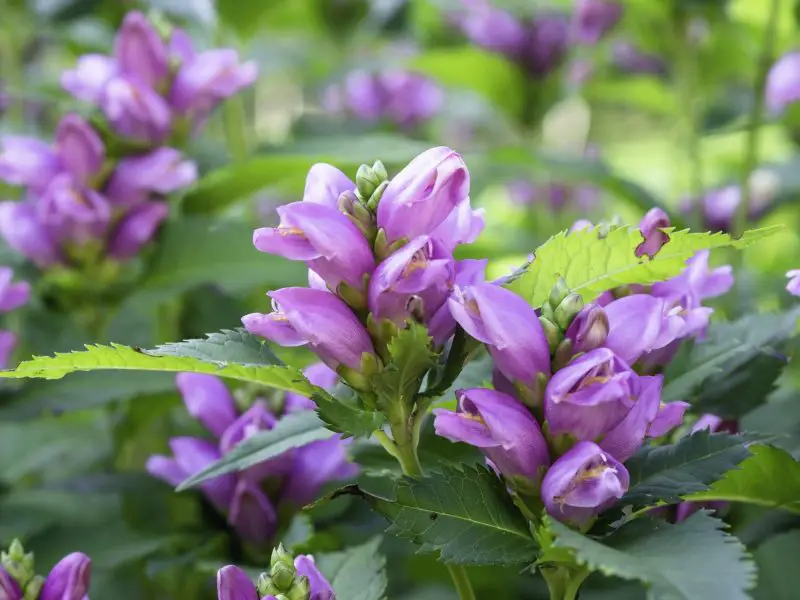
Turtleheads are clump-forming perennials that produce unique, hooded flowers resembling a turtle’s head, hence their name. The blooms come in shades of pink, white, or purple and grow in upright spikes above deep green foliage, adding texture and interest to autumn gardens.
They bloom from late August through October and thrive in USDA hardiness zones 3 to 8. Turtleheads are easily identified by their distinctive flower shape and glossy, toothed leaves. They are commonly found in moist, shady areas and are known to attract butterflies and hummingbirds.
Plant turtleheads in partial shade with rich, consistently moist soil. Regular watering is essential, especially during dry spells, as they prefer damp conditions. Adding organic mulch helps retain soil moisture, and cutting back the stems after flowering encourages compact growth and healthy regrowth in the following spring.
Perennial Sunflowers (Helianthus)
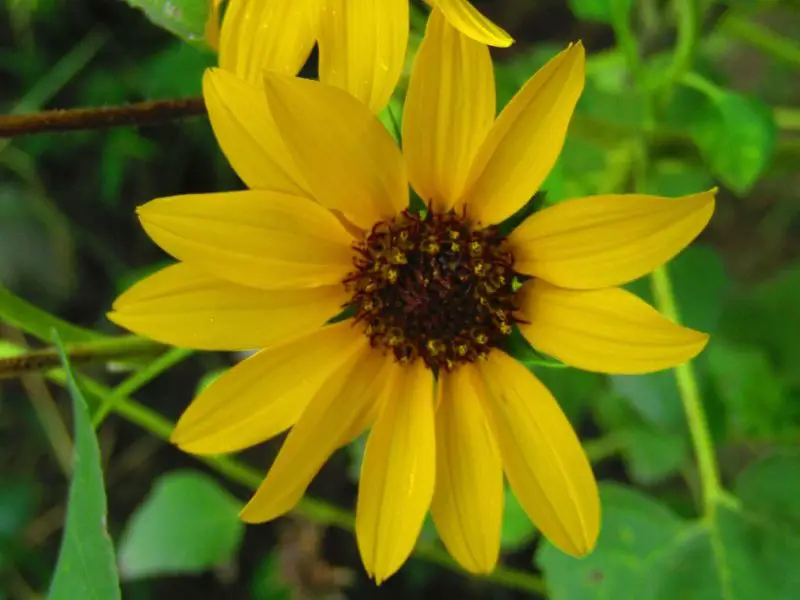
Perennial sunflowers are late-blooming relatives of the common annual sunflower, bringing cheerful golden-yellow blooms to autumn gardens. Their daisy-like flowers are smaller than the classic sunflower but grow in clusters, creating a bright and lively display. Tall varieties can reach up to 6 feet, making them excellent for the back of borders.
They bloom from late August through October and thrive in USDA hardiness zones 4 to 9. These sunflowers are easily recognized by their bright yellow petals and dark central discs, along with their rough, lance-shaped leaves. They are excellent pollinator plants, attracting bees and butterflies in late autumn.
Plant perennial sunflowers in full sun with well-draining soil. They are drought-tolerant once established, requiring only occasional watering. Cutting them back after flowering keeps them tidy and helps control their spreading habit, as some varieties can naturalize aggressively in ideal conditions.
Obedient Plants (Physostegia virginiana)
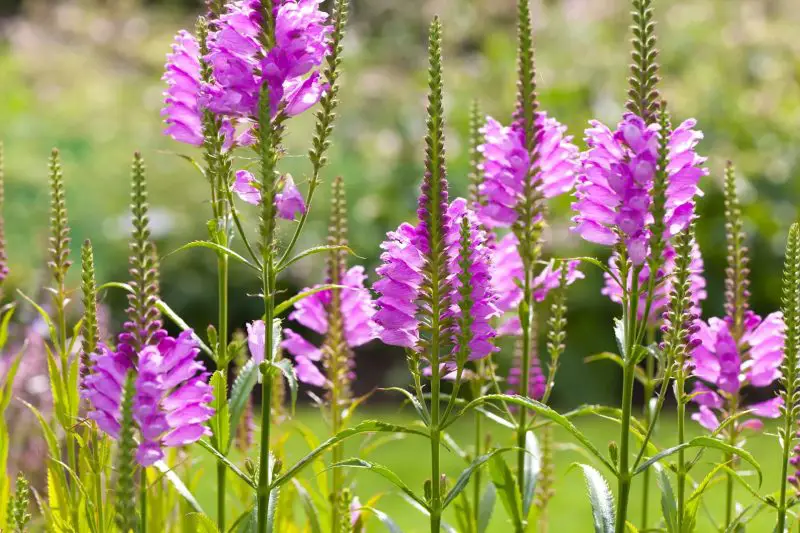
Obedient plants are upright perennials that produce spikes of tubular flowers in shades of pink, lavender, or white. The name comes from the flowers’ ability to stay in place when gently pushed to one side, making them a fun addition to gardens. Their tall, vertical form adds structure and height to autumn borders.
They bloom from late summer through mid-autumn, typically from August to October, and thrive in USDA hardiness zones 3 to 9. Obedient plants are easily recognized by their square stems, lance-shaped leaves, and dense flower spikes that attract hummingbirds and bees.
Plant them in full sun to partial shade with moist, well-draining soil. They prefer consistent watering, especially in dry conditions. Cutting them back after flowering can encourage a second flush of blooms, while dividing clumps every few years prevents overcrowding and keeps plants healthy.
Coreopsis (Late-Blooming Varieties)

Late-blooming coreopsis varieties bring a final burst of yellow, orange, or red to gardens in early and mid-autumn. These cheerful daisy-like flowers grow on slender stems above fine, feathery foliage, creating a delicate, airy appearance in borders and containers.
They bloom from late August through October and thrive in USDA hardiness zones 4 to 9. Coreopsis is easily identified by its bright, sunny flowers and thin, thread-like leaves. It is a favorite among pollinators, especially bees and butterflies, providing nectar late in the season.
Plant coreopsis in full sun with well-draining soil. These hardy perennials are drought-tolerant once established, needing minimal care apart from occasional watering during dry spells. Deadheading encourages continuous flowering, and cutting back plants after the season keeps them neat and ready for regrowth in spring.
Gaillardias (Blanket Flowers)
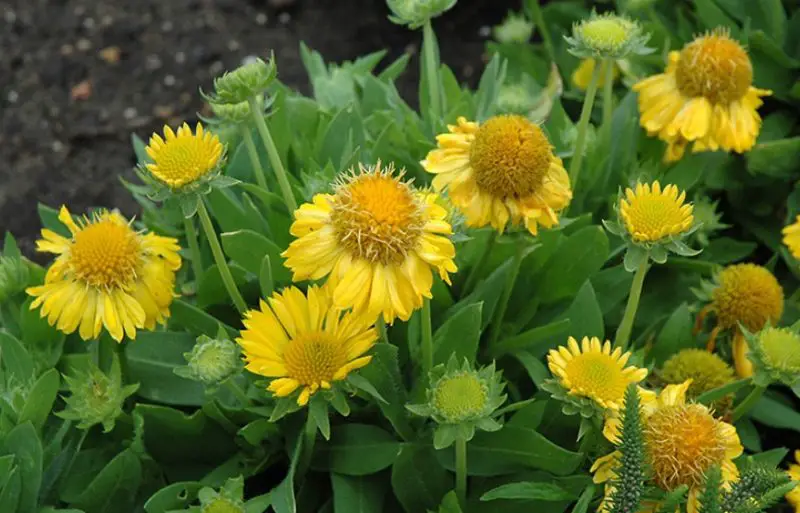
Gaillardias, or blanket flowers, are long-blooming perennials that extend their vibrant color well into autumn. Their daisy-like flowers feature bold shades of red, orange, and yellow, often with contrasting centers, creating a striking display in gardens and containers.
They bloom from early summer through the first frost, making them a reliable choice for continuous autumn color. Gaillardias thrive in USDA hardiness zones 3 to 10 and are easily recognized by their bi-colored petals and slightly hairy gray-green leaves. These flowers also attract pollinators, especially bees and butterflies, throughout the season.
Plant blanket flowers in full sun with well-draining soil. They are drought-tolerant and thrive in poor, sandy soils, making them low-maintenance. Deadheading spent blooms prolongs flowering, while cutting them back after frost prepares them for strong regrowth the following spring.
Autumn Gentians (Gentiana)
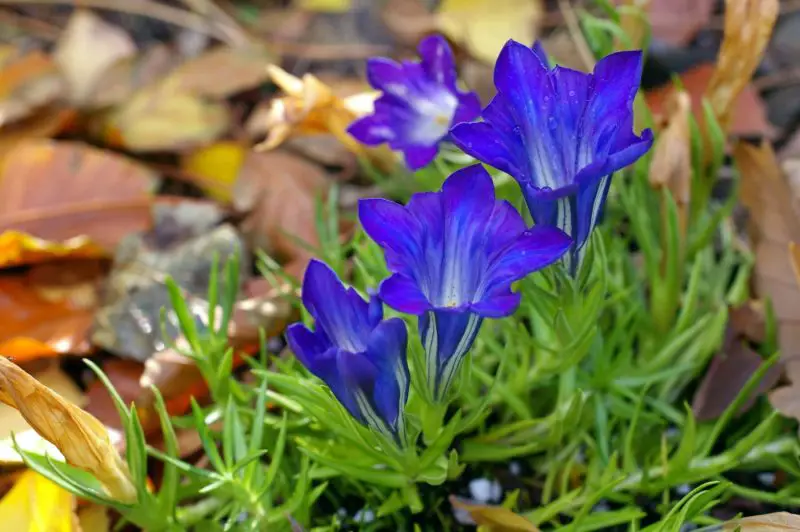
Autumn gentians are striking perennials that produce trumpet-shaped flowers in rich shades of deep blue or violet. Their vivid color contrasts beautifully with traditional autumn tones, making them an eye-catching addition to fall gardens and rockeries.
They bloom from September through October and thrive in USDA hardiness zones 3 to 7. Autumn gentians are easily recognized by their glossy, lance-shaped leaves and clusters of upward-facing, tubular flowers. Their intense blue color makes them a favorite among collectors of unique perennials.
Plant them in full sun to partial shade with moist, well-draining, slightly acidic soil. Regular watering is important, as gentians prefer consistently moist conditions but do not tolerate waterlogging. Mulching helps retain soil moisture, and dividing plants every few years ensures healthy growth and abundant flowering.
Mexican Bush Sage (Salvia leucantha)

Mexican bush sage is a stunning perennial shrub known for its velvety, purple-and-white or purple-and-lavender flower spikes. Its soft, gray-green foliage adds texture to gardens, while its long-lasting blooms attract hummingbirds and butterflies, making it a favorite in fall landscapes.
It blooms from late summer through the first frost, often peaking in September and October. Mexican bush sage thrives in USDA hardiness zones 8 to 11, though it can be grown as an annual in cooler regions. Its arching stems covered with fuzzy flower spikes make it easily recognizable in borders and container gardens.
Plant Mexican bush sage in full sun with well-draining soil. It is drought-tolerant once established and requires minimal watering except during long dry spells. Cutting back spent flower spikes encourages new growth, and pruning in late winter or early spring helps maintain a compact, bushy form.
Sweet Alyssum (Late-Season Blooms)
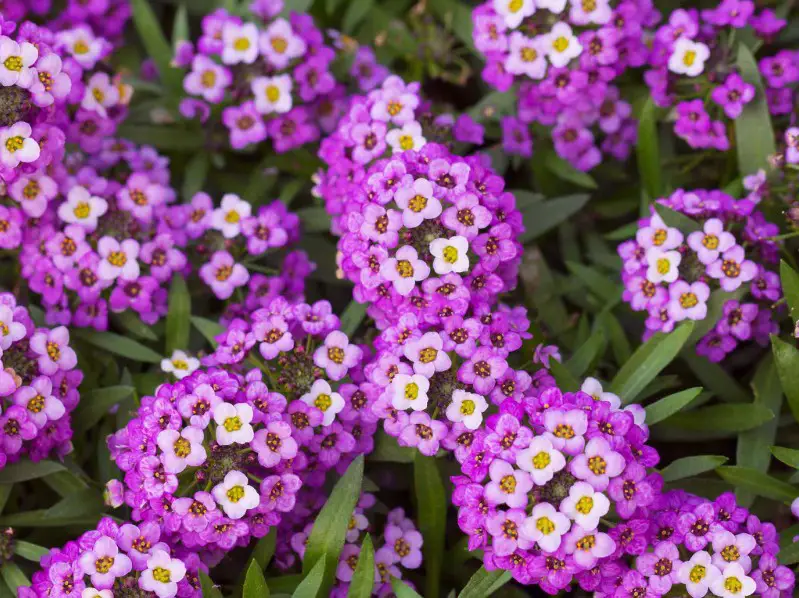
Sweet alyssum is a low-growing annual or short-lived perennial that produces clusters of tiny, honey-scented flowers. The blooms come in white, pink, lavender, or purple, forming dense mats that soften garden edges and fill containers with cascading color.
It can bloom from spring until frost, with a strong flush of flowers returning in the cooler temperatures of autumn. Sweet alyssum thrives in USDA hardiness zones 5 to 9, reseeding itself readily in favorable conditions. It is easily recognized by its small, cross-shaped flowers and delicate, trailing stems.
Plant sweet alyssum in full sun to partial shade with well-draining soil. It prefers regular watering but tolerates short dry periods once established. Pinching back leggy stems and deadheading spent flowers encourage bushier growth and continuous blooming through autumn.
Marigolds (Tagetes – Fall Plantings)
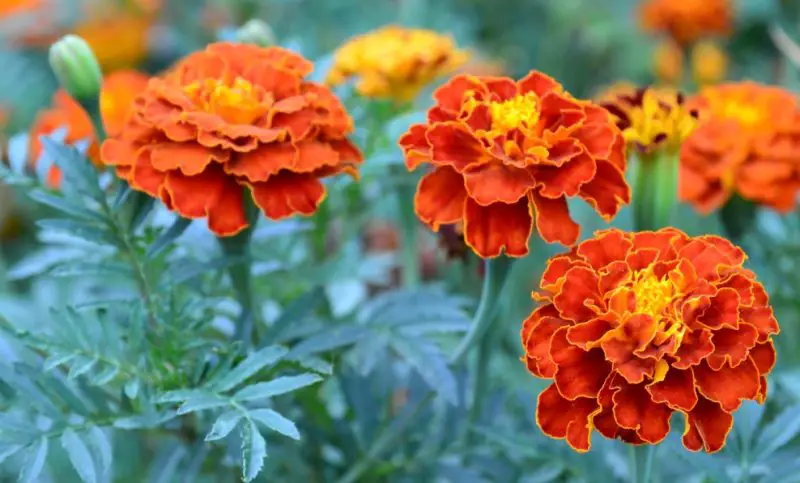
Marigolds are hardy annuals that bring cheerful golden, orange, and yellow blooms to gardens well into autumn. Their ruffled flowers and distinctive, spicy fragrance make them popular for borders, vegetable gardens, and containers. Some varieties also deter garden pests naturally.
They bloom from summer until the first frost, thriving especially in the cooler weather of early to mid-autumn. Marigolds are suitable for USDA hardiness zones 2 to 11, grown as annuals everywhere. They are easily recognized by their rounded, pompon-like or single daisy-like blooms and feathery, dark green foliage.
Plant marigolds in full sun with well-draining soil. They require minimal care, needing only moderate watering and occasional deadheading to encourage continuous blooms. In regions with mild autumns, marigolds can remain colorful until frost, making them a reliable fall bedding plant.
Zinnias (Cooler Autumn Varieties)
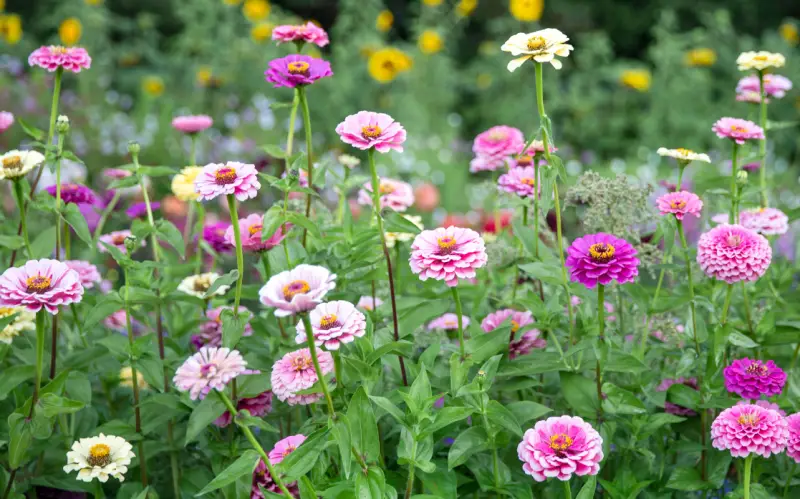
Zinnias are vibrant annuals known for their bold, daisy-like or dahlia-like flowers in a wide range of colors, including red, pink, yellow, orange, and purple. They add a splash of cheerful color to autumn gardens and are popular as cut flowers due to their long-lasting blooms.
They can bloom until the first frost, especially in regions with mild autumns. Zinnias thrive in USDA hardiness zones 3 to 10, grown as annuals. They are easily recognized by their layered, brightly colored petals and stiff, upright stems that attract butterflies throughout the season.
Plant zinnias in full sun with well-draining soil. They prefer moderate watering and benefit from deadheading to prolong blooming. In areas with cooler autumn nights, zinnias often develop deeper, richer colors, making them particularly striking in fall displays.
Cosmos (Autumn Blooms in Mild Regions)
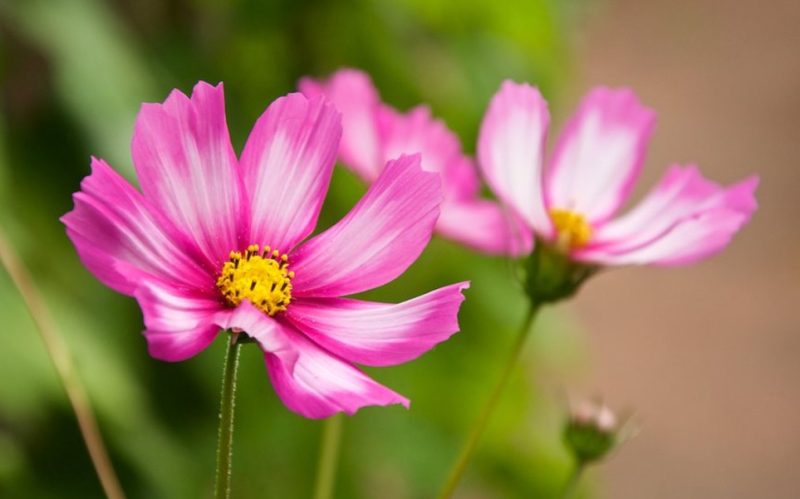
Cosmos are airy annuals that produce delicate, daisy-like flowers in shades of pink, white, red, or purple. Their feathery foliage and tall, slender stems give them a light, graceful appearance, making them perfect for naturalistic or cottage-style gardens.
They bloom continuously from summer until frost, thriving especially in the cooler temperatures of early autumn. Cosmos grow well in USDA hardiness zones 2 to 11 as annuals. They are easily recognized by their finely divided, fern-like leaves and bright, open-faced flowers that attract bees and butterflies.
Plant cosmos in full sun with well-draining, moderately fertile soil. They require minimal care, tolerating poor soils and occasional dry conditions. Deadheading keeps the flowers coming, and leaving some spent blooms to form seeds encourages natural reseeding for the following year.
Veronica (Speedwell – Late-Blooming Types)
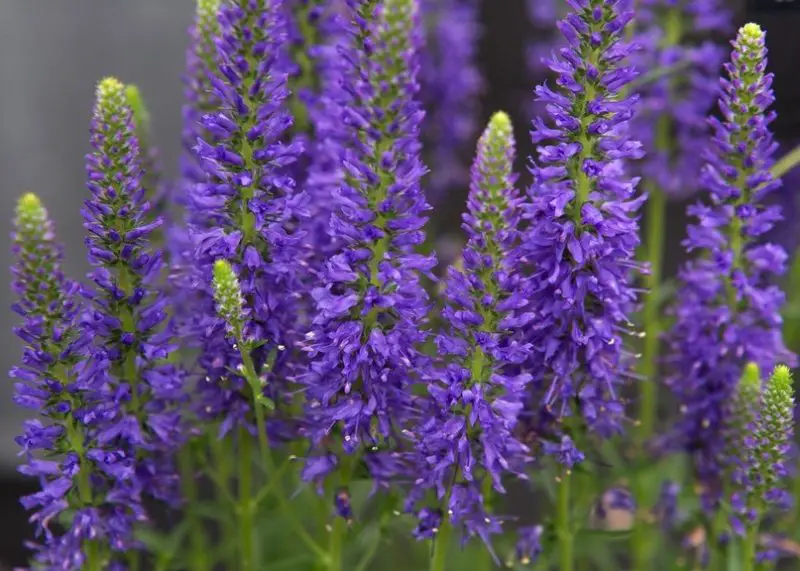
Veronica, also known as speedwell, is a hardy perennial that produces graceful spikes of small, tubular flowers in shades of blue, purple, pink, or white. Its dense flower spikes add vertical interest to borders and attract a variety of pollinators, including bees and butterflies.
Late-blooming varieties flower from late summer into early autumn, sometimes lasting until October. Veronica thrives in USDA hardiness zones 3 to 8. It is easily recognized by its upright spikes of tiny, closely packed flowers and its lance-shaped, toothed leaves.
Plant veronica in full sun with well-draining soil. It prefers moderate watering and benefits from deadheading to extend blooming. Cutting plants back after flowering encourages a compact shape and healthy regrowth the following season.
Snapdragons (Autumn Plantings)
Snapdragons are cool-season annuals or short-lived perennials that produce colorful spikes of dragon-shaped flowers in red, yellow, pink, purple, white, and bicolor combinations. Their name comes from the way the flower “mouth” opens when gently squeezed.
They bloom best in the cool temperatures of spring and autumn, often peaking in fall in regions with mild weather. Snapdragons thrive in USDA hardiness zones 7 to 10 as short-lived perennials and in cooler zones as annuals. They are easily identified by their tall, spiky flower clusters and narrow green leaves.
Plant snapdragons in full sun with rich, well-draining soil. Regular watering and occasional fertilizing encourage more blooms. Deadheading spent flowers extends the flowering period, and in warm climates, snapdragons may continue blooming until the first frost.
Calendulas (Pot Marigolds – Autumn Varieties)
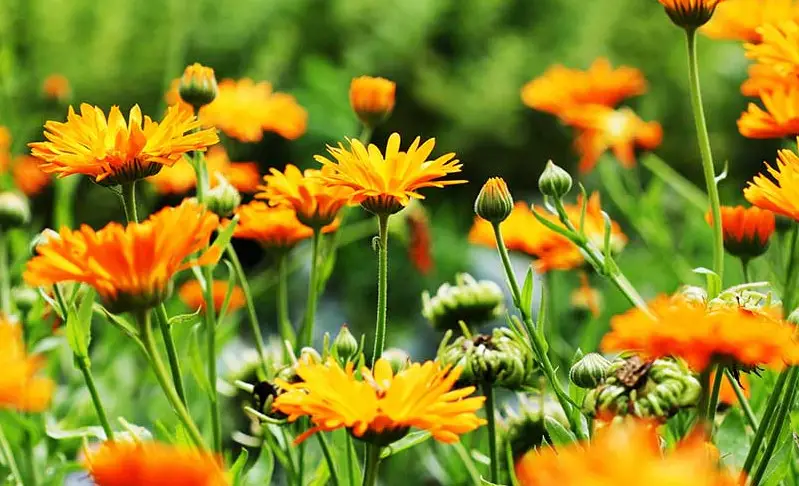
Calendulas, often called pot marigolds, are cheerful annuals that produce daisy-like flowers in shades of orange and yellow. Their bright blooms are edible and often used as garnishes or in herbal remedies. In fall gardens, they add a warm, sunny touch to borders and containers.
They thrive in the cooler weather of autumn, blooming from September until frost in many regions. Calendulas grow well in USDA hardiness zones 2 to 11 as annuals. They are easily recognized by their ruffled petals, resinous fragrance, and slightly sticky, green leaves.
Plant calendulas in full sun with moderately fertile, well-draining soil. They require regular watering but dislike overly wet conditions. Deadheading keeps flowers coming, and in mild climates, they can self-seed, returning the following year.
Anise Hyssop (Agastache foeniculum)
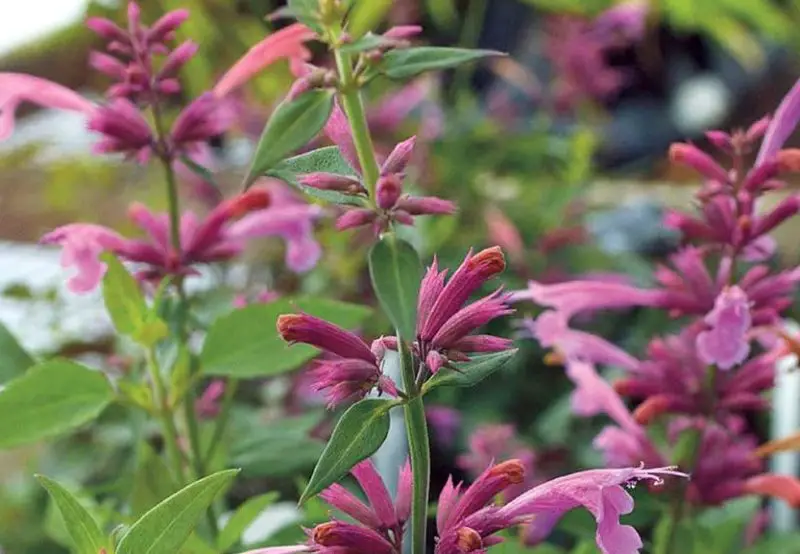
Anise hyssop is a fragrant perennial with upright spikes of tiny purple or blue flowers that bloom late into autumn. Its aromatic, anise-scented leaves add an extra layer of appeal, and the plant is highly attractive to bees, butterflies, and hummingbirds.
It blooms from mid-summer through October, thriving in USDA hardiness zones 4 to 9. Anise hyssop is easily identified by its mint-like, serrated leaves and dense, spiky flower clusters. Its long blooming period makes it a valuable nectar source for pollinators in the fall.
Plant anise hyssop in full sun with well-draining soil. It is drought-tolerant once established and requires minimal care, though deadheading can prolong flowering. Cutting the stems back in late fall or early spring promotes healthy growth the following year.
Pineapple Sage (Salvia elegans)
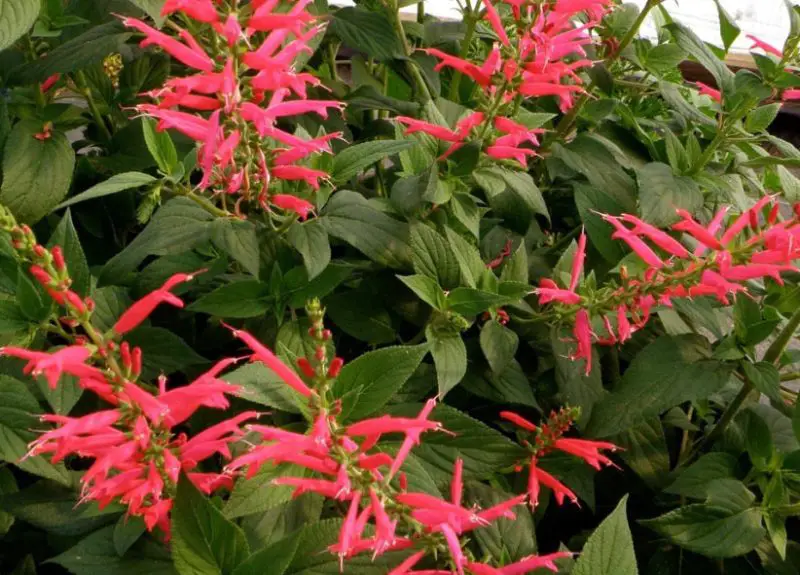
Pineapple sage is a fragrant herbaceous perennial that produces brilliant red, tubular flowers in autumn. Its bright green, pineapple-scented leaves add ornamental and culinary interest, making it both a decorative and useful plant.
It typically blooms from September through November, thriving in USDA hardiness zones 8 to 11, though it is grown as an annual in cooler regions. Pineapple sage is easily recognized by its vibrant flower spikes and soft, aromatic leaves. Its blooms are especially attractive to hummingbirds.
Plant pineapple sage in full sun with rich, well-draining soil. Regular watering keeps the plant healthy, especially during dry spells. Pruning spent flower stems encourages bushier growth, and in mild climates, it can grow into a large, shrubby perennial that blooms reliably each fall.
Russian Sage (Perovskia atriplicifolia)
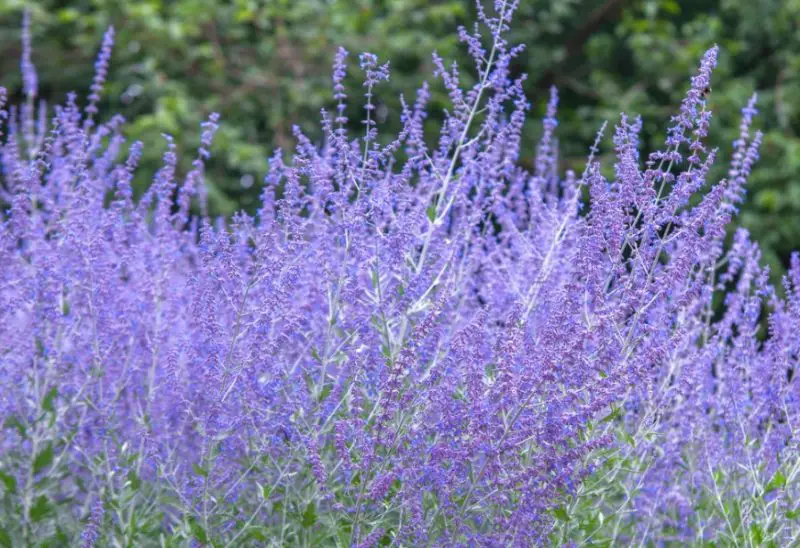
Russian sage is a hardy perennial shrub that produces airy sprays of tiny lavender-blue flowers on tall, silvery-gray stems. Its finely divided, aromatic foliage and soft, cloud-like flower clusters add a delicate texture to fall gardens.
It blooms from late summer through October, thriving in USDA hardiness zones 4 to 9. Russian sage is easily recognized by its wispy, upright stems covered with small tubular flowers and its fragrant, silvery-green leaves. The plant attracts bees and butterflies, providing a valuable late-season nectar source.
Plant Russian sage in full sun with well-draining soil. It is highly drought-tolerant once established, requiring minimal care. Cutting stems back to about 12 inches in late winter or early spring encourages healthy new growth and keeps the plant compact.
Cuphea (Cigar Plant)
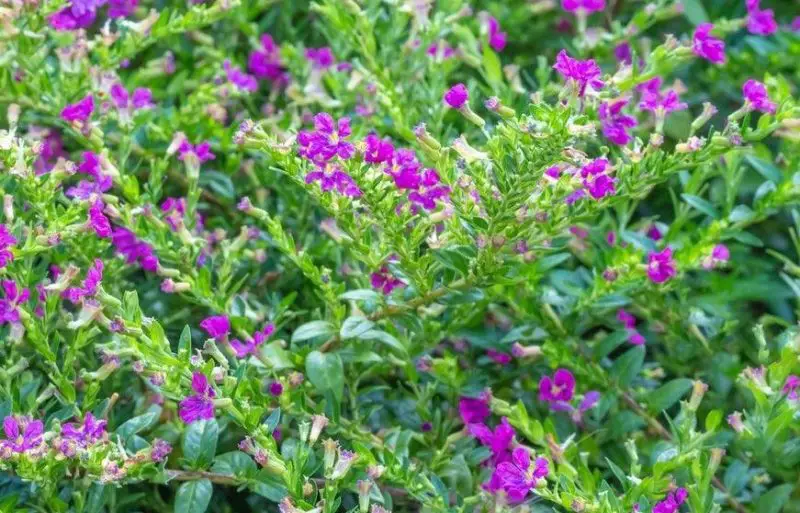
Cuphea, commonly known as the cigar plant, is a tropical perennial that produces small, tubular, cigar-shaped flowers in shades of red, orange, or purple. Its continuous blooms and bright colors make it a standout choice for autumn borders and containers.
It blooms from summer until the first frost, thriving particularly well in the cooler temperatures of fall. Cuphea grows best in USDA hardiness zones 9 to 11 but is grown as an annual in cooler regions. It is easily recognized by its distinctive tubular flowers and lush, bright green foliage.
Plant cuphea in full sun with rich, well-draining soil. It prefers regular watering, especially during dry periods, and benefits from light pruning to maintain a tidy shape. Its long blooming season makes it a reliable source of color until frost.
Sweet Autumn Clematis (Clematis terniflora)
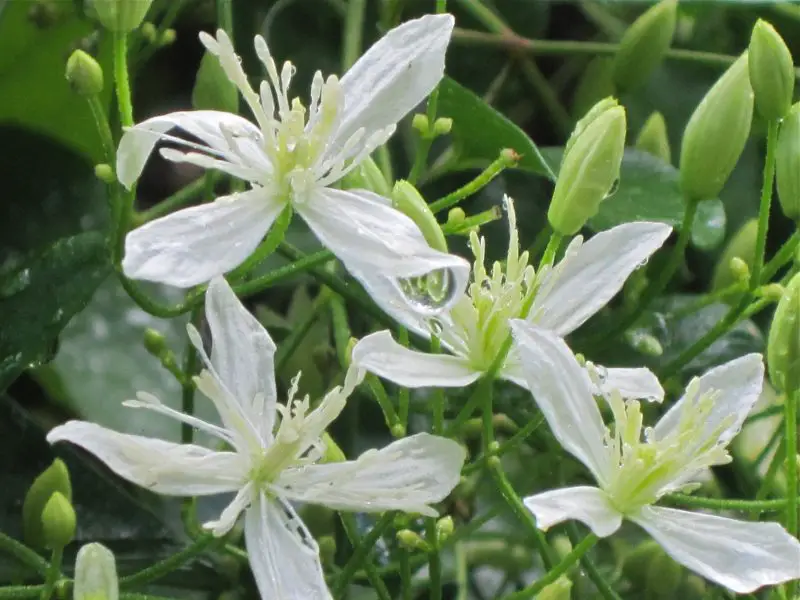
Sweet autumn clematis is a vigorous, fast-growing vine that produces masses of small, star-shaped white flowers with a sweet fragrance. Its abundant blooms create a striking, cascading effect on trellises, fences, or pergolas in the fall garden.
It blooms profusely from late August through September, thriving in USDA hardiness zones 4 to 9. This clematis is easily recognized by its glossy green leaves and clusters of fragrant white flowers that cover the vine during peak bloom.
Plant sweet autumn clematis in full sun to partial shade with well-draining soil. Regular watering during dry spells encourages abundant flowering. Pruning after flowering helps control its vigorous growth and prepares it for healthy regrowth in spring.
Fuchsia (Hardy Varieties)
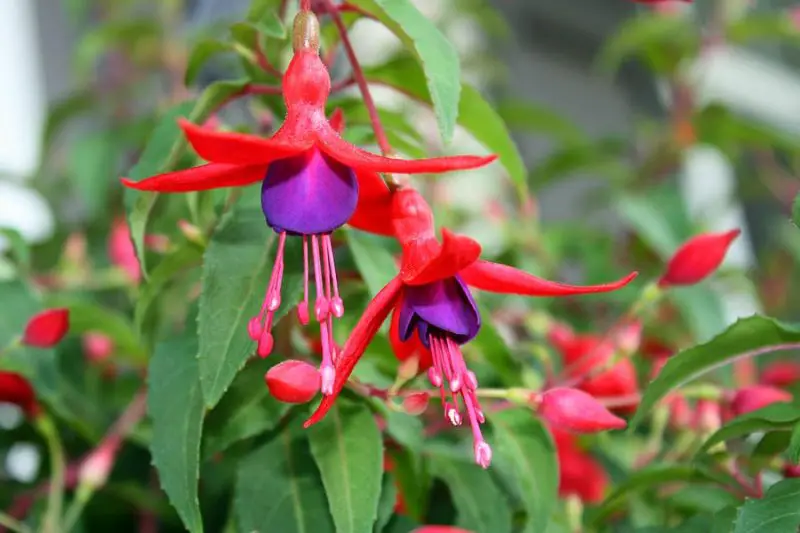
Hardy fuchsia varieties continue blooming well into autumn, producing pendulous, bell-shaped flowers in shades of pink, purple, and red. Their elegant flowers add a splash of vibrant color to borders and containers in cooler fall weather.
They bloom from summer through the first frost, performing best in mild autumns. Hardy fuchsias thrive in USDA hardiness zones 6 to 9. They are easily recognized by their drooping, lantern-like flowers and glossy, serrated green leaves.
Plant hardy fuchsias in partial shade with moist, well-draining soil. They require regular watering, especially during dry periods, and benefit from deadheading to prolong flowering. In colder regions, adding mulch around the base helps protect the roots over winter.
Persicaria (Knotweed or Fleeceflower)
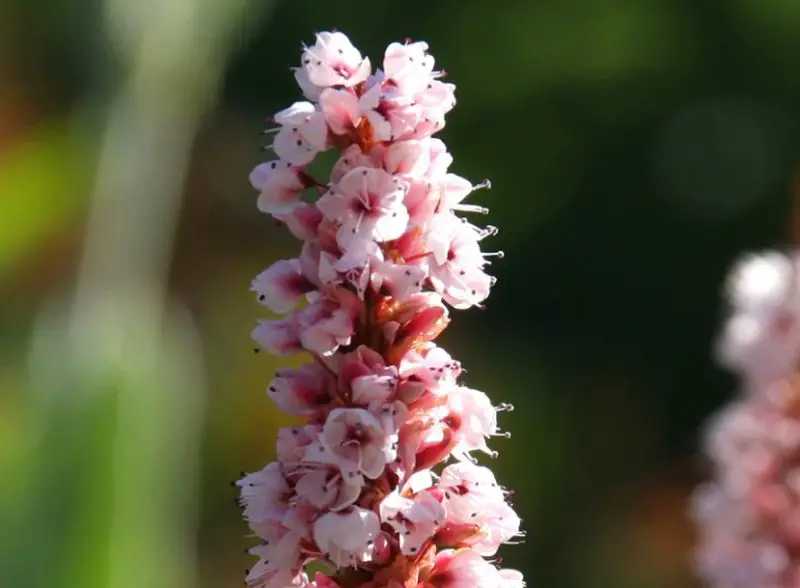
Persicaria, also called knotweed or fleeceflower, is a clump-forming perennial that produces long, slender spikes of tiny pink, red, or white flowers. Its airy, swaying blooms add texture and movement to autumn gardens.
It blooms from late summer through October, thriving in USDA hardiness zones 4 to 9. Persicaria is easily recognized by its elongated flower spikes and lance-shaped green leaves that create a lush backdrop in borders.
Plant persicaria in full sun to partial shade with moist, well-draining soil. It prefers consistent watering, especially during dry spells, and benefits from cutting back old flower spikes after blooming. Some varieties can spread vigorously, so dividing clumps every few years helps control growth.
Boltonia (False Aster)
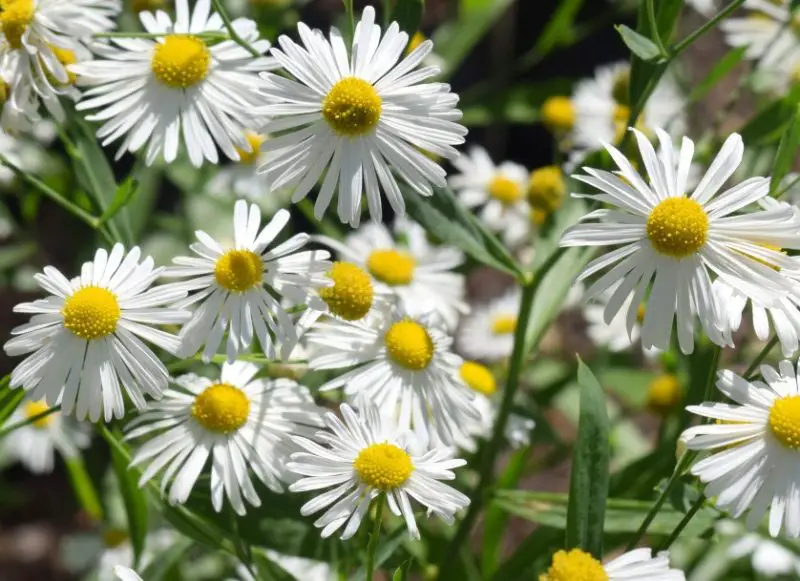
Boltonia, commonly known as false aster, is a tall, bushy perennial that produces masses of small, daisy-like flowers in shades of white, lavender, or pale pink. Its airy, cloud-like clusters add a soft, natural look to autumn borders and wildflower gardens.
It blooms from late August through October, thriving in USDA hardiness zones 4 to 9. Boltonia is easily identified by its narrow, lance-shaped leaves and profusion of tiny aster-like flowers. Bees and butterflies are frequent visitors, making it an excellent pollinator-friendly plant for the fall season.
Plant boltonia in full sun with well-draining soil. It prefers moderate watering and tolerates short dry periods once established. Tall varieties may need staking to prevent flopping, and cutting back stems after flowering keeps the plant compact and vigorous for the next growing season.
Hardy Hibiscus (Late-Blooming Varieties)
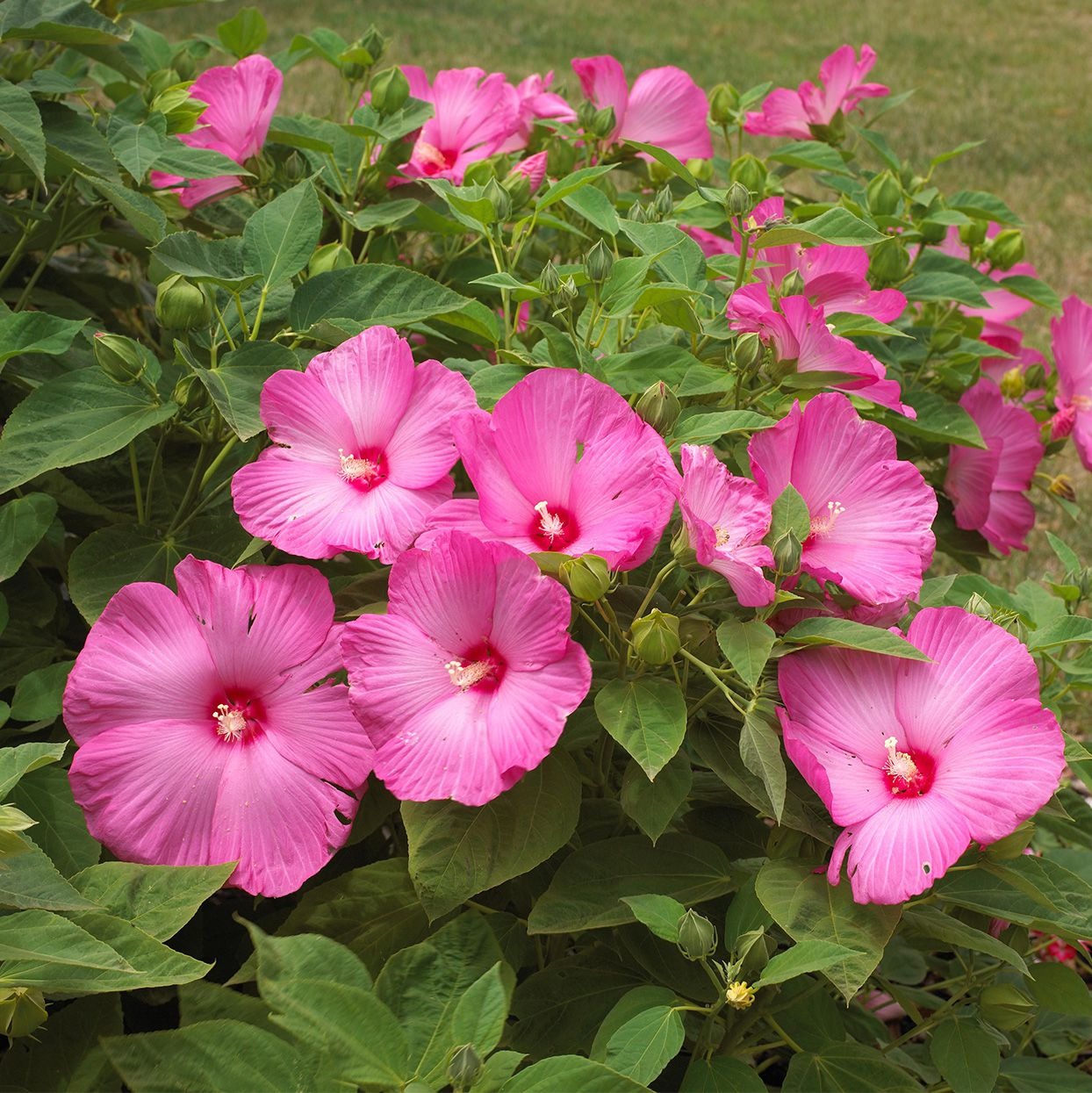
Late-blooming hardy hibiscus varieties, such as Hibiscus moscheutos, bring dramatic color to autumn gardens with their enormous, dinner-plate-sized blooms in shades of red, pink, or white. Their tropical appearance makes them standout plants in late-season landscapes.
They bloom from late summer into early autumn, often peaking in September. Hardy hibiscus thrives in USDA hardiness zones 5 to 9. It is easily recognized by its huge, ruffled petals and lush, deep green or burgundy-tinged foliage.
Plant hardy hibiscus in full sun with rich, moist, well-draining soil. Regular watering is essential, as they prefer consistently damp conditions. Cut stems back to the ground after frost to encourage vigorous regrowth in spring, and mulch around the base in colder regions for winter protection.
Sweet Autumn Clematis (Clematis terniflora)

Sweet autumn clematis is a fast-growing vine that produces cascades of fragrant, star-shaped white flowers in fall. Its abundant blooms create a spectacular display on fences, trellises, or pergolas, adding elegance and fragrance to autumn gardens.
It blooms from late August through September and thrives in USDA hardiness zones 4 to 9. The vine is easily recognized by its glossy green leaves and masses of small, sweetly scented flowers. It also attracts pollinators, making it both decorative and beneficial for wildlife.
Plant sweet autumn clematis in full sun to partial shade with well-draining soil. Provide regular watering during dry periods to encourage heavy flowering. Prune after blooming to control its vigorous growth and maintain a tidy appearance for the following season.
FAQs About Flowers That Bloom in Autumn
What flowers bloom the longest in autumn?
Some of the longest-blooming autumn flowers include chrysanthemums, asters, salvias, and blanket flowers (gaillardias). These plants often continue to bloom from late summer until the first frost, providing continuous color throughout the fall season.
Which flowers attract pollinators in autumn?
Asters, goldenrods, salvias, and anise hyssop are excellent choices for attracting pollinators such as bees, butterflies, and hummingbirds. These flowers provide a vital source of nectar and pollen when other summer flowers have faded.
Can I grow autumn-blooming flowers in containers?
Yes, many autumn-blooming flowers such as chrysanthemums, marigolds, pansies, and ornamental kale grow well in containers. Choose well-draining pots, use quality potting soil, and water regularly to keep the plants healthy.
What are the best low-maintenance autumn flowers?
Sedums, Russian sage, coreopsis, and Mexican bush sage are among the best low-maintenance flowers for autumn. They are drought-tolerant, require minimal fertilizing, and continue blooming with little care.
Can autumn-blooming flowers survive frost?
Some autumn flowers, like pansies, ornamental kale, and certain varieties of asters, can tolerate light frost and continue blooming. However, tender plants like zinnias and marigolds will die back after the first hard frost.
What USDA zones are suitable for autumn flowers?
Most autumn-blooming flowers thrive in USDA hardiness zones 3 to 9, but tropical varieties such as Mexican bush sage and pineapple sage are better suited for warmer zones (8 to 11). Always check the specific zone requirements for each species before planting.
When should I plant flowers for autumn blooms?
For perennials, plant them in spring or early summer to establish strong roots before fall. For annuals like marigolds or zinnias, plant them in late spring to early summer so they can bloom continuously into autumn.






